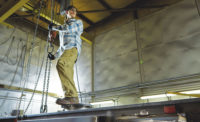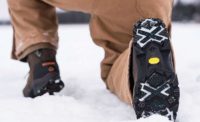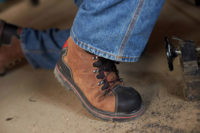Members of the new generation workforce have a work hard, play hard mentality. They actively pursue their interests and take pride in their accomplishments. They tend to live in their boots - they wear their work boots during the week and their old work boots on the weekend to go hiking or hunting. These younger consumers strive to leave a lasting mark on the world through the results of their work. They are resilient and expect the same of their footwear and apparel on the job.
The younger consumer likes classic brands but is also eager to try new technologies and products that interest him or her. These consumers gravitate toward brands that help them live every day to the fullest and that align with their values - hard working, well-crafted, durable, and tough. The right footwear appeals to the younger worker entering the boot market and has added benefits of high performance and leading technology.
Athletic influences
The central fact about today’s young work consumers is that they grew up wearing athletic footwear. This affects the expectations they have about the functionality of work boots as well as their ideas about what makes them visually attractive. It is not surprising these consumers are drawn to athletic-inspired performance benefits in their work footwear.
From a functional point of view, work boots need to present traditional features of durability and protection with the combined comfort and feel of an athletic sneaker. Again, the younger consumer enjoys classic brands but also wants to see emerging and exciting technologies introduced by these brands.
Lightening the load
Safety-toe boots that are made with toe-caps other than the traditional steel-toe provide the protection needed in a work boot while reducing weight (versus steel) and enhancing comfort. New non-steel toe-caps deploy carbon-based nanotechnology 40 percent lighter than steel. They provide the needed protection with less volume than conventional safety toes. More toe room means more comfort.
Cushioning technologies that provide the comfort of high-grade athletic footwear are important. Materials, design and construction all play a part. Advanced polyurethane and EVA compounds coupled with designs and shoe-making that bring the cushioning closer to the foot help fight fatigue in work footwear -- normally worn for long periods of time. The younger consumers spend hours in their boots during the day and their footwear needs to be able to flex with every step and provide comfort from heel to toe. Athletic cushioning technologies help distribute weight more evenly and also absorb impact and return energy more effectively.
Changing aesthetics
The old rules of what a work boot has to look like are changing. The standard eight-inch Goodyear® Welt boot has to compete now with more athletically-inspired six-inch, mid-cut, and oxford looks. Modern work boots combine traditional leather upper material with performance fabrics and rubber/plastic tech pieces. Combinations of classic materials and performance fabrics enable boots to leverage the best characteristics of each and can result in lightweight, breathable and flexible uppers.
The look and technology in modern boot outsoles are also changing. Outsoles are featuring technologies inspired by high-performance sport footwear that incorporates effort-maximizing energy return systems.
Colors
The opportunity to use color has also opened up as younger consumers enter the work boot market. This extends from putting small pops of color on traditional boot patterns to full-blown displays of color on athletic-looking work hikers and oxfords. The basic black and brown options are increasingly supplemented with an array of colors of varying dosages.
There are many influences affecting the design and development of the modern work boot. These include technology, color, materials, and designs that are inspired by athletic footwear. All of these influences factor into the way the younger work force look at what footwear would best suit them.






